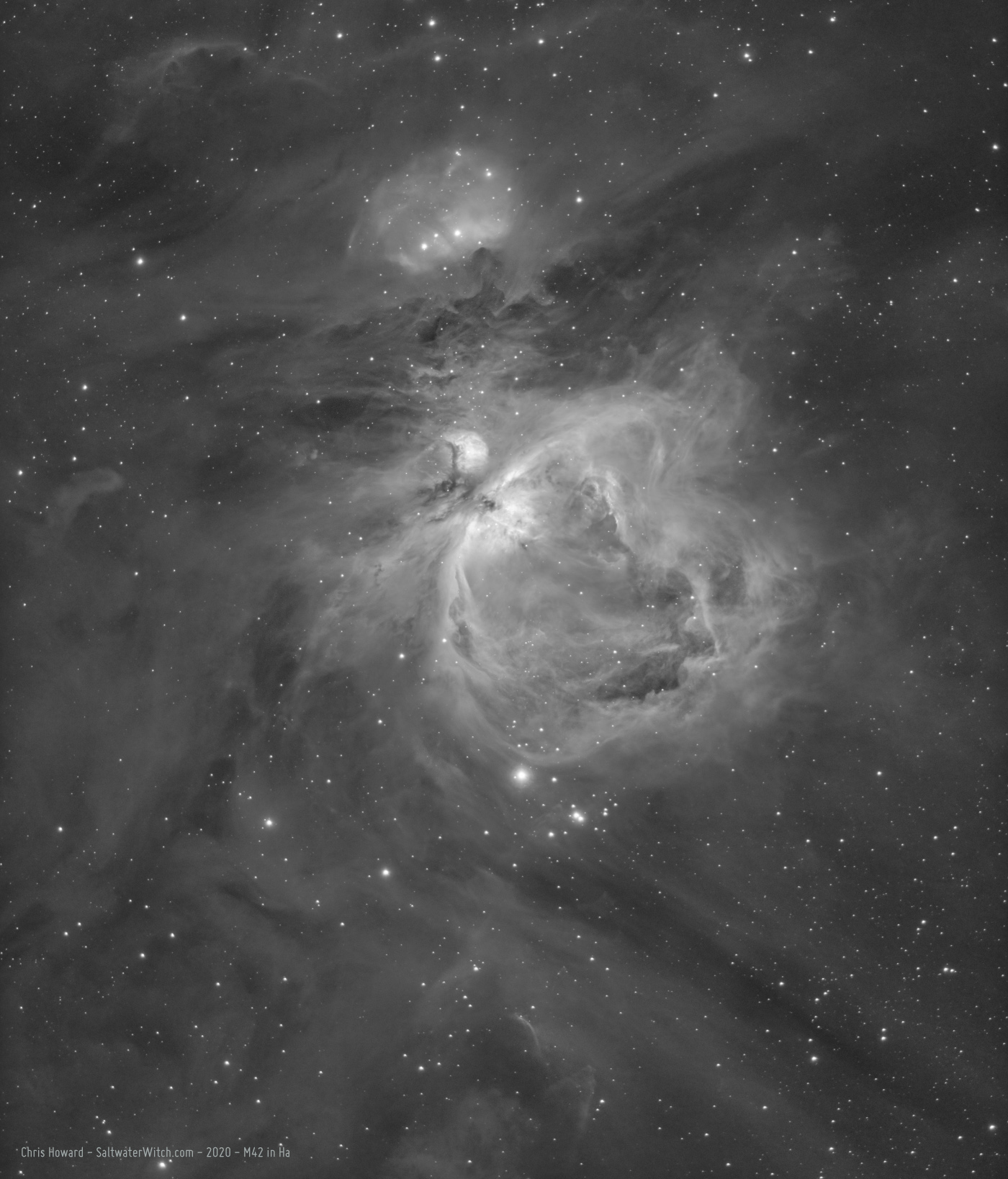Testing the Narrowband Rig with the New OTA
First narrowband test with the new Apertura Newtonian scope, although it was barely a test—31 sub-exposures in Ha before the clouds started rolling in, and with a very bright full moon in the sky. IC 1396 is a large (3 degrees in diameter) emission nebula and star-forming region in the constellation Cepheus, about 2400 lightyears away. Within IC 1396 is the Elephant's Trunk Nebula catalogued as IC 1396A, pictured here in hydrogen-alpha (narrowband). This structure is well over a hundred trillion miles long (roughly 20 lightyears), so if you want to get from the top to the bottom you'd better have a pretty fast vehicle.
Notes: 31 x 240 second subs in Ha. Apertura 8" Newtonian 880mm FL at f/4.4, ZWO ASI1600MM-Pro monochrome camera, Astronomik 6nm Hydrogen-alpha filter, SkyWatcher EQ6-R Pro mount, controller: INDI/Ekos/KStars. I managed to capture 31 subs of IC1396A, but no calibration frames—that's only half the subs I would normally want for this one in Hydrogen-alpha. I was not dithering here either, which is something I normally have on, and the result is some "walking noise" which is pattern noise in one direction--top-right to bottom left, in this case, introduced either by polar alignment drift or differential flexure between the guide scope and the OTA (this is the most likely suspect here, but not absolutely sure). Guiding total RMS averaged around 1 arcsecond the whole time, not the best, but I attributed it to the full moon, lack of contrast, but who knows. I didn't see any walking noise with the color rig, but even so, I'm going to go with off-axis guiding next time th eskies clear and see what happens!
Clouds swept in around midnight, and then it rained through the night, so I took what I could get and did some mild processing. There's serious coma around the edges. I have the stars pretty well dialed in with the color train, but not here. I have some measuring and caliper work to do!
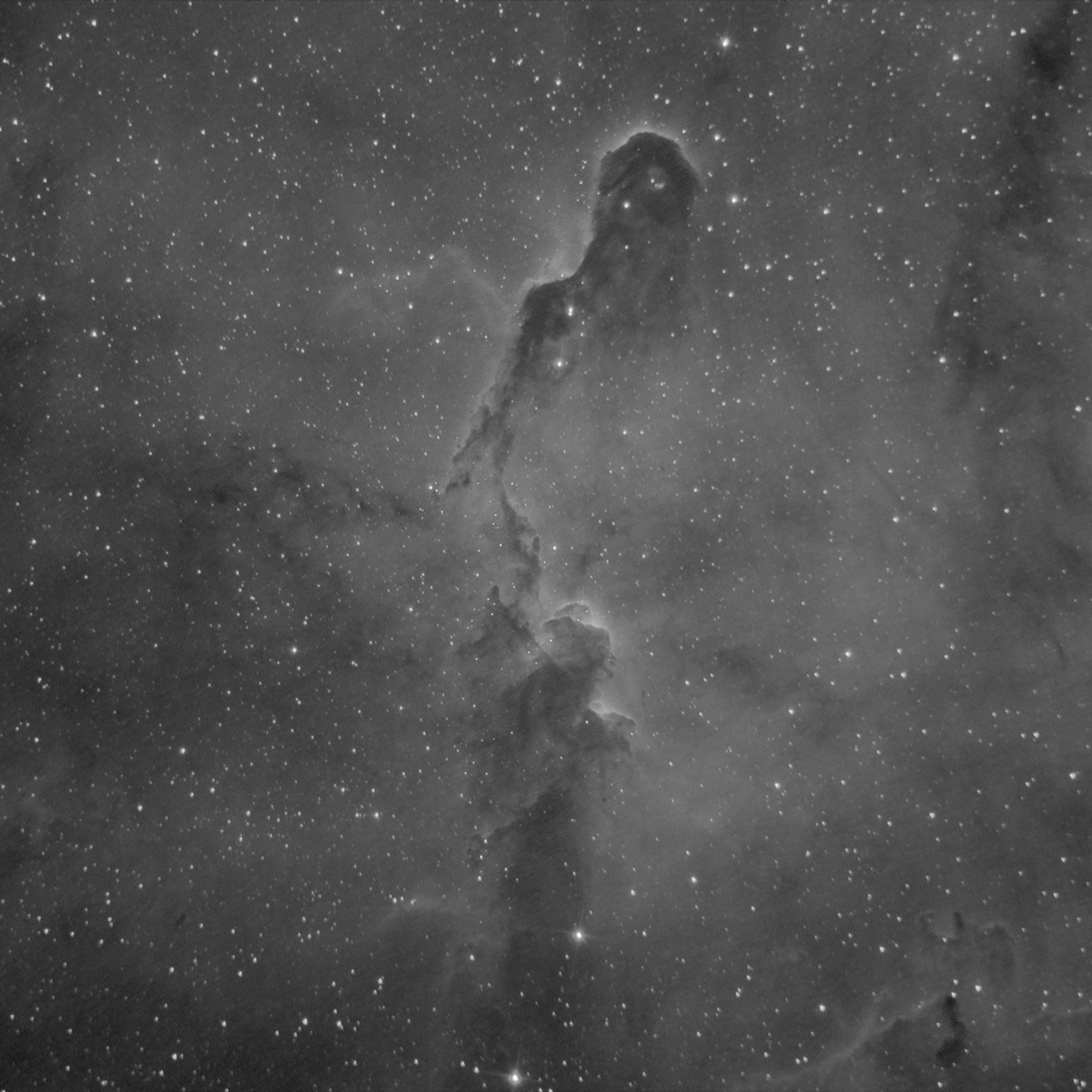
The area around the constellation Cepheus is an astrophotography buffet, and because the constellation is circumpolar, it's in the night sky for at least half the year—if you're anywhere near the north. Both the Iris Nebula and the Fireworks Galaxy, two amazing deep sky objects I captured last week, are here, along with the Elephant's Trunk nebula, Cave and Wizard nebulas—and a lot more! Some of these targets span the border with Cassiopeia at the bottom.
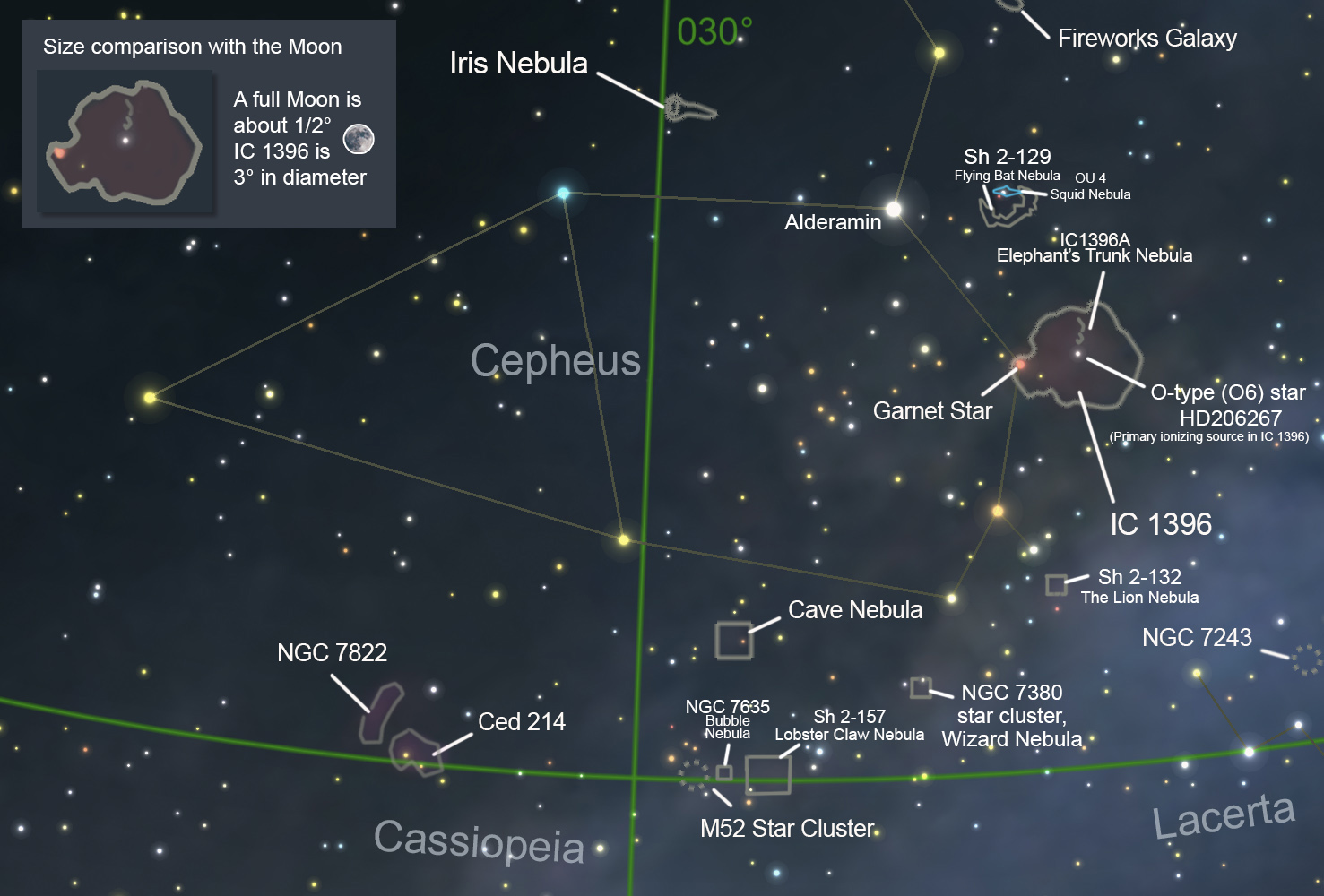
BiColor version of the central region of the Elephant's Trunk Nebula--Hydrogen-alpha and Oxygen 3:
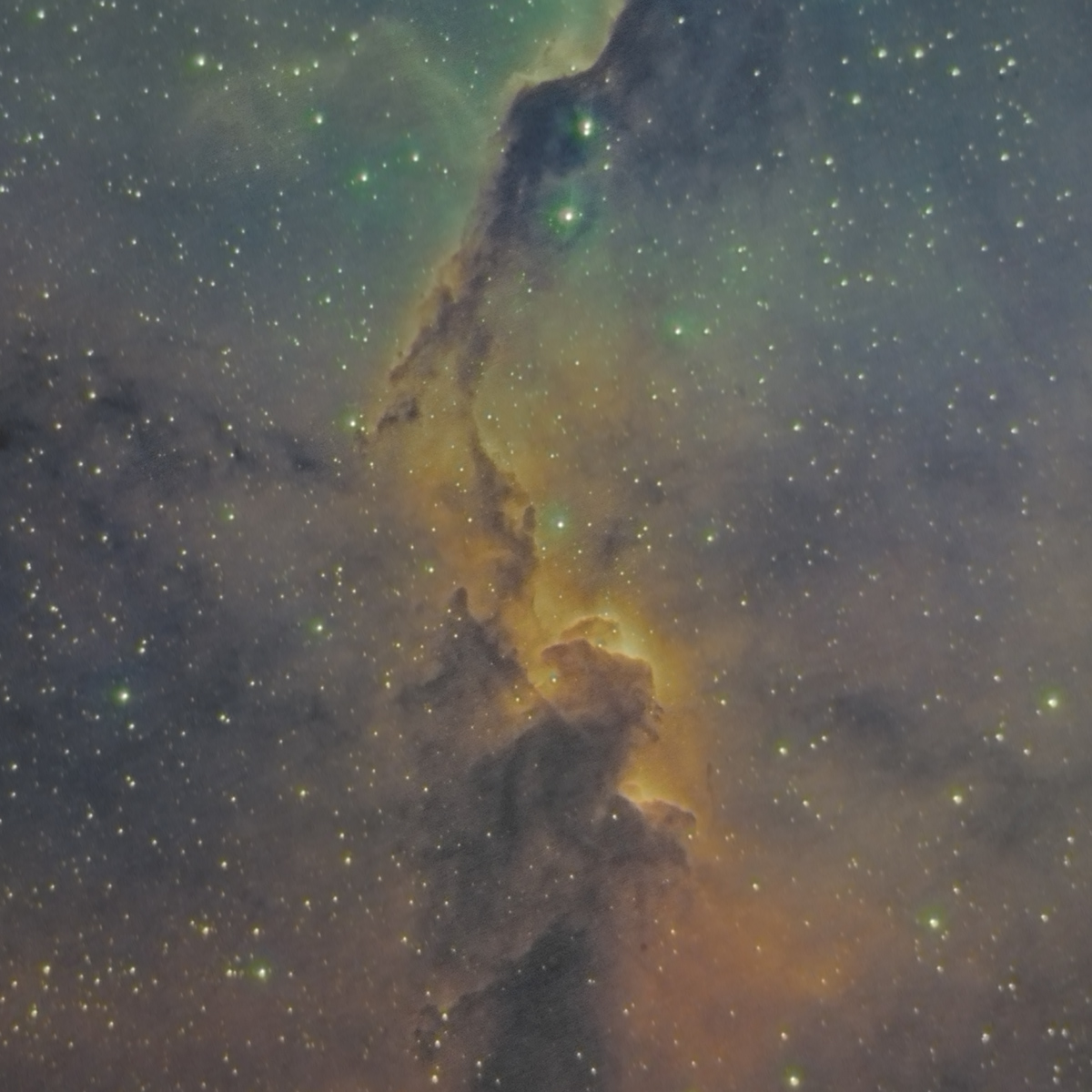
Posted June 25, 2021
Second night out with the Apertura 8" Newt
I selected IC 5146, the Cocoon Nebula as a nice broadband color target for my second clear night with the Newt, and at 800mm focal length, the Cocoon should fit nicely in the frame, with room for the long trail of dust flowing away from it--if I can manage it.
Mechanics: the stars only look slightly better tonight, still wacky around the edges. They were a coma-induced mess last night, but I rearranged some of the imaging train and...it looks, well, not much better. But I'll get there. I am not the type to spend all night twiddling with spacers and digital calipers to calculate the correct back-distance and eliminate every last trace of coma. I'd rather image, and make small corrections along the way, even if it means the stars look like crap before I get things properly dialed in.
So, I was also looking for a nice target to shoot while the Cocoon climbed a bit higher in the sky, more than 30°, and I went for NGC 6946, Caldwell 12, the Fireworks Galaxy in Cepheus. I don't normally go for galaxies, unless they're relatively close by, but there are a few like M101 (Pinwheel Galaxy) and M81 (Bode's Galaxy) which are great targets if you're running with less than a 1000mm--other than the obvious ones like M31, M33, LMC, etc.
The Fireworks Galaxy is 22 million lightyears away. To put that distance in perspective, one lightyear is almost 6 trillion miles. I'll leave the multiplying by 22 million up to you. Fireworks is a medium-sized galaxy, about half the size of the Milky Way at about 40,000 lightyears across. It's a spiral galaxy, and it has the advantage, from our perspective, of being face-on, or is that top-down? Notes: 31 x 120 second subs, no filters.
NGC 6946, Caldwell 12, the Fireworks Galaxy in Cepheus:
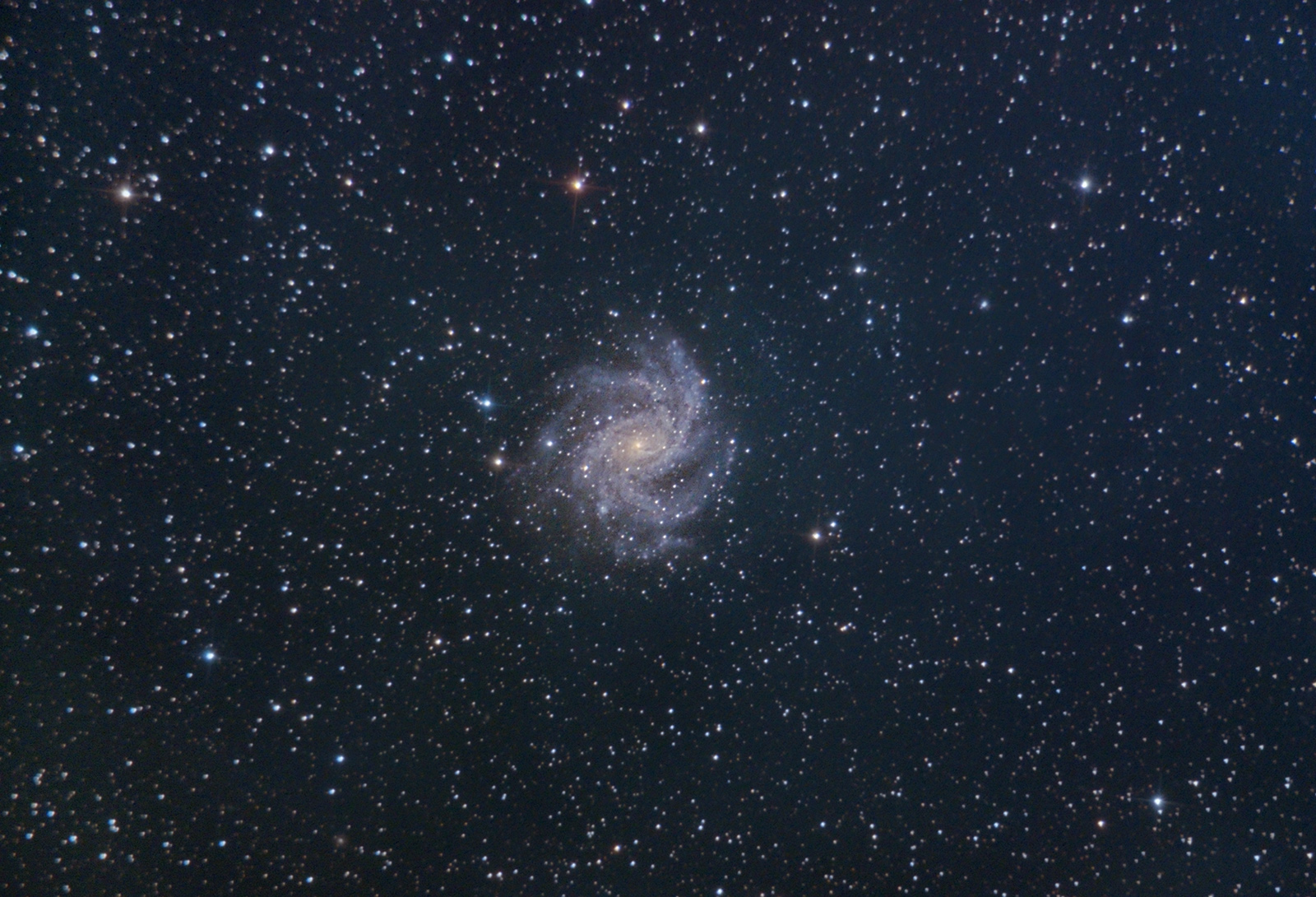
The Cocoon Nebula (IC 5146, Caldwell 19, Sh 2-125) is a roiling mix of new stars, ionized gases emitting light, mostly in wavelengths out at the hydrogen end of the spectrum, with additional layers of clouds of dust and gas lit up by those same stars. Actually, most of the ionizing weight appears to be carried by the central pre-main-sequence B type star, BD+46°3474. The whole circular structure labeled IC 5146 is a reflection nebula and an H ii region that forms a "cocoon" around BD+46°3474 (that bright star in the center), which is probably less than a 1 million years old and is probably closer to 100,000 years old (compare that to our star, the Sun, at 4.6 billion years old). This central star's intense radiation and stellar winds have hollowed out the dense molecular clouds, and the radiation flowing off it is ionizing the material and lighting it up. There's a long dark band of gas trailing off frame at the bottom of this image that leads to a separately identified dark nebula, Barnard 168 (B168). The Cocoon is around 2500 lightyears away in the constellation Cygnus. Imaging Notes: There's so much going on here across the visual spectrum right on out to hydrogen-alpha and near-infrared. Most color astro cameras, DSLRs, and mirrorless cameras will be able to pick it all up. If you can, light pollution allowing, try to catch the Cocoon Nebula without any extra filters. My imaging run: 67 x 240 second subs, no filters. Apertura 8 inch f/4 800m FL Imaging Newtonian, ZWO ASI071MC color camera, GSO Coma Corrector, SkyWatcher EQ6-R Pro mount, Stellarmate/Raspberry Pi 4 running INDI/Ekos/KStars.
IC 5146, the Cocoon Nebula in Cygnus:
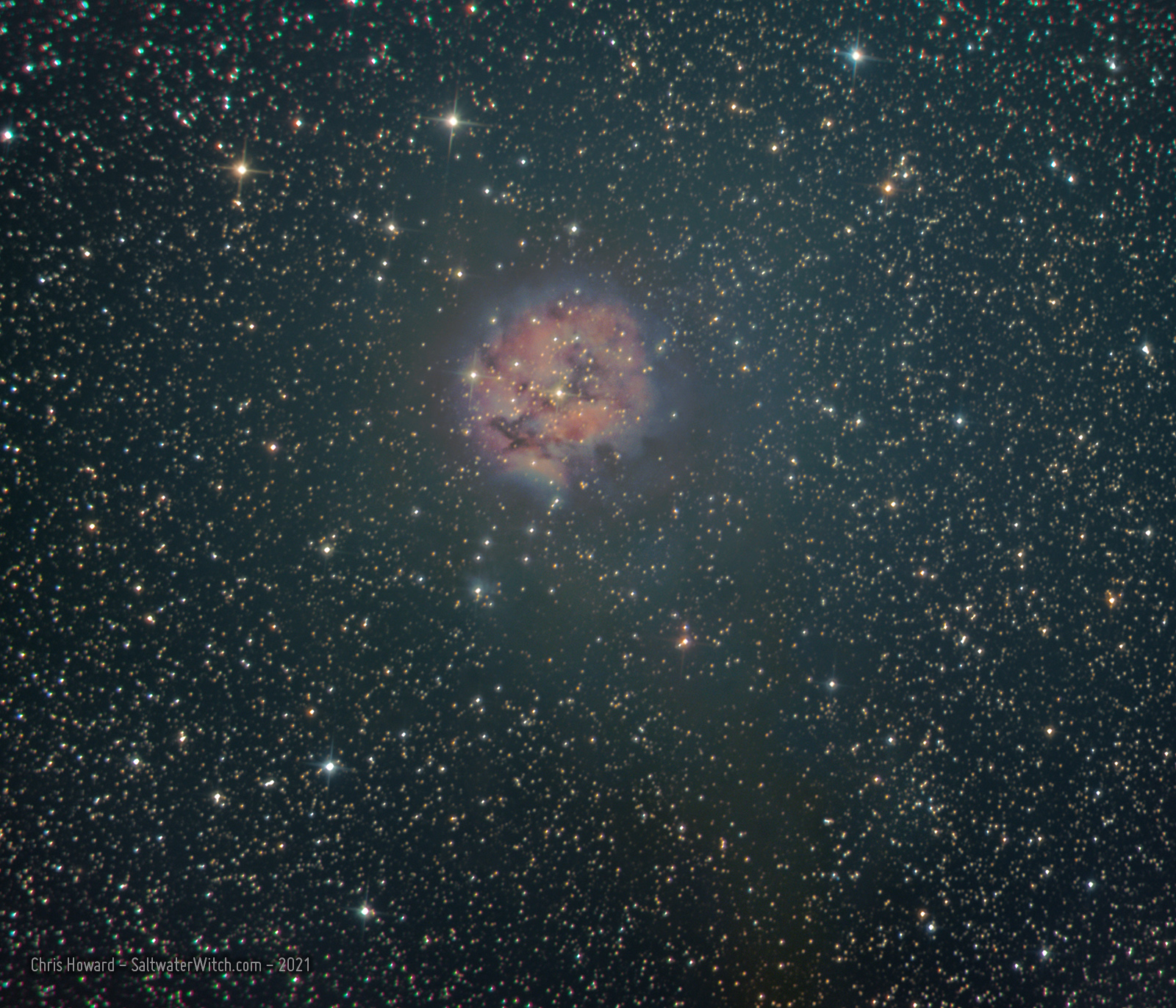
Posted June 18, 2021
NGC 6820
NGC 6820 (Sh2-86) in hydrogen-alpha narrowband. This emission nebula in the constellation Vulpecula is made up of one vast pillar and several not-so-vast pillars of dark molecular dust and gases that have been eroded by the driving stellar winds and intense radiation of the star cluster NGC 6823 (above NGC 6820 in this rotation). Did someone say, "Bok globules"? Yeah, we got those, small dense chunks of dust and gas (hydrogen, carbon, helium, silicates, etc.) that lead to star formation. Of course, small is relative in this case. You can probably take a dozen copies of our entire solar system, including the Kuiper Belt and Oort Cloud and easily fit them all inside most. I gave this monochrome image a hint of vintage tint, a bit or warmth, to counter the core temperatures of Bok globules, which are thought to be some of the coldest objects in the universe. It also makes the image appear a bit brighter.

Posted June 11, 2021
Coathanger Cluster and Dark Nebulae
That's why our galaxy is called the Milky Way. The starfield is so dense along the galactic plane, especially as you move toward the core, that the merged brightness of stars is all you see. This is a shot of the "coathanger" cluster--that's the four stars making a hook in the center with the line of stars running underneath (Al Sufi's Cluster, Brocchi's Cluster, Cr 399). The dark clouds in this frame are just that, massive clouds of interstellar dust, molecular hydrogen, and other debris that swirls around our galaxy between the stars--especially between us and these stars--because that's pretty much everything else. It's dust and stars. There are hundreds of billions of stars in the Milky Way and as you look toward the center, you are looking through a hundred-thousand lightyears of the stellar disk--everything that orbits in the galaxy with us. We're 27,000 lightyears out from the core, so you are looking through that as well as everything orbiting on the other side of the core. Yup, it's a bunch of stars, as many as 400 billion just in our galaxy.
I will admit to not being a star cluster guy. Some of them are absolutely fascinating, but they're just not my thing. You show me some dark nebulae, anything from the Barnard Catalog or Lynd's Dark Nebula Catalog, and I'm there. There are a few stand-out dark nebulae below this frame to the right (LDN 770, 778), but there are a batch in this frame including LDN 740, and lower left LDN 741, 745.
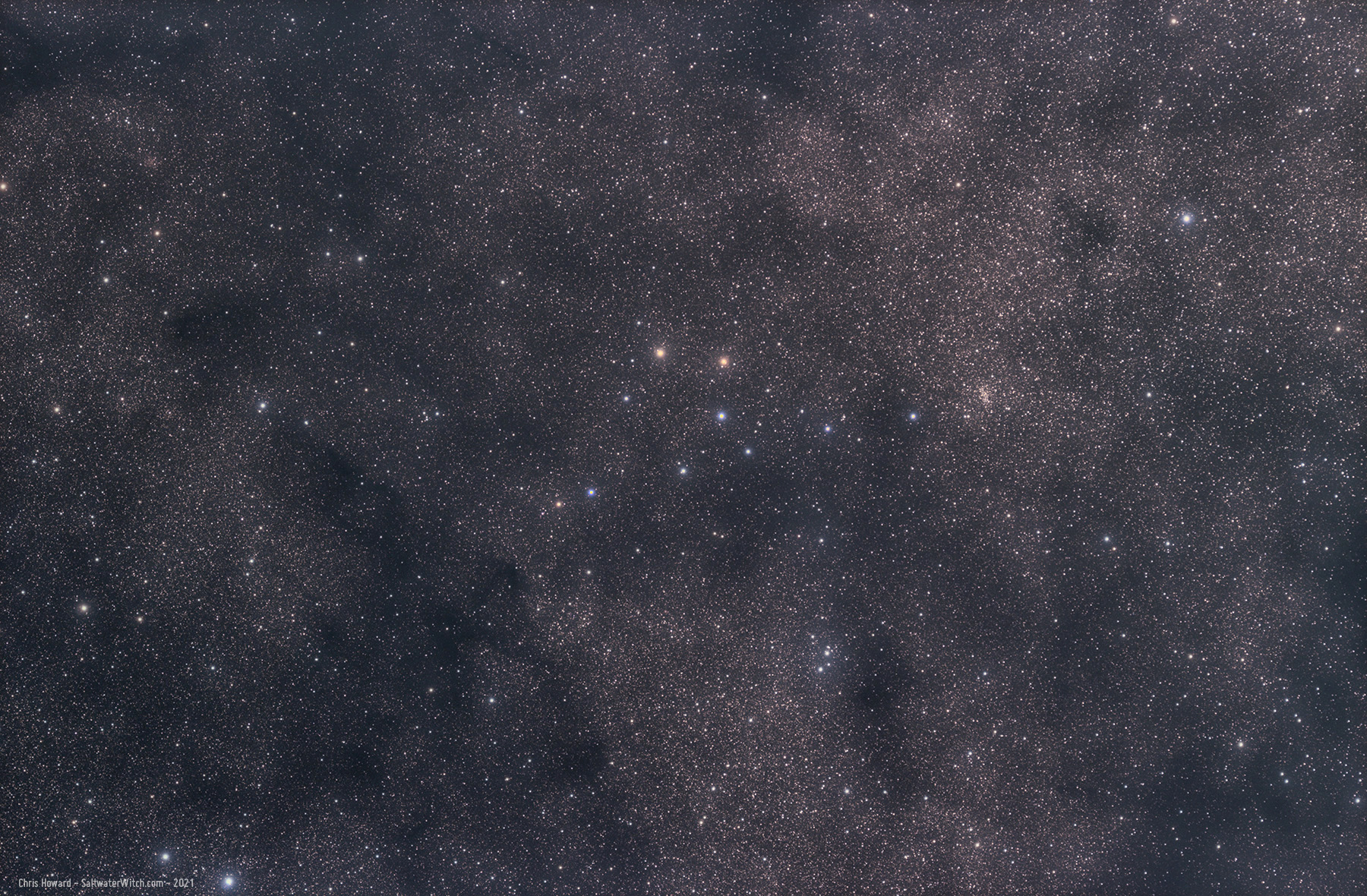
Notes: This is 81 x 60-second sub-exposures stacked in DSS and processed in PS2021. Equipment: William Optics SpaceCat 51 APO refractor, ZWO ASI071MC, no filters, DeepSkyDad AF3 focuser, iOptron CEM25P mount.
Posted May 16, 2021
So, How's the New Backyard Pier Going?
 That's the big question. Over the last couple weeks I have had five clear nights of imaging with the new pier—the pier allows me to keep my astro gear setup semi-permanently. I park the scope at the end of the night, shut everything down, throw the cover over it and cinch it up. Done. (I bought a TeleGizmos 365 Series Cover for 8-10" SCT from OPT several months back, but I'm just starting to use it now). There were three rainy days between these image captures, and a couple nights that dipped below zero (low 20°s F/ -6C). I left the mount and scope set up in the rain, protected by the cover, and with a couple bags of desiccant, the equipment was completely dry. Unlike a tripod, the pier allows me to tighten the cover around the post under all the equipment, holding off any moisture that might rise up from wet grass and ground.
That's the big question. Over the last couple weeks I have had five clear nights of imaging with the new pier—the pier allows me to keep my astro gear setup semi-permanently. I park the scope at the end of the night, shut everything down, throw the cover over it and cinch it up. Done. (I bought a TeleGizmos 365 Series Cover for 8-10" SCT from OPT several months back, but I'm just starting to use it now). There were three rainy days between these image captures, and a couple nights that dipped below zero (low 20°s F/ -6C). I left the mount and scope set up in the rain, protected by the cover, and with a couple bags of desiccant, the equipment was completely dry. Unlike a tripod, the pier allows me to tighten the cover around the post under all the equipment, holding off any moisture that might rise up from wet grass and ground.
So, how's the pier functioning? Perfectly. My goal was to be able to setup my gear and leave it outside for long periods—maybe weeks, and not have to polar align after the first night. I did run through a polar align the second night because I wanted to see how well it maintained alignment, and it was right on. I have now gone through three more imaging sessions without polar aligning! I simply check the weather, pull off the cover, power up everything, and begin my first sequence of the night. It really has been that simple.
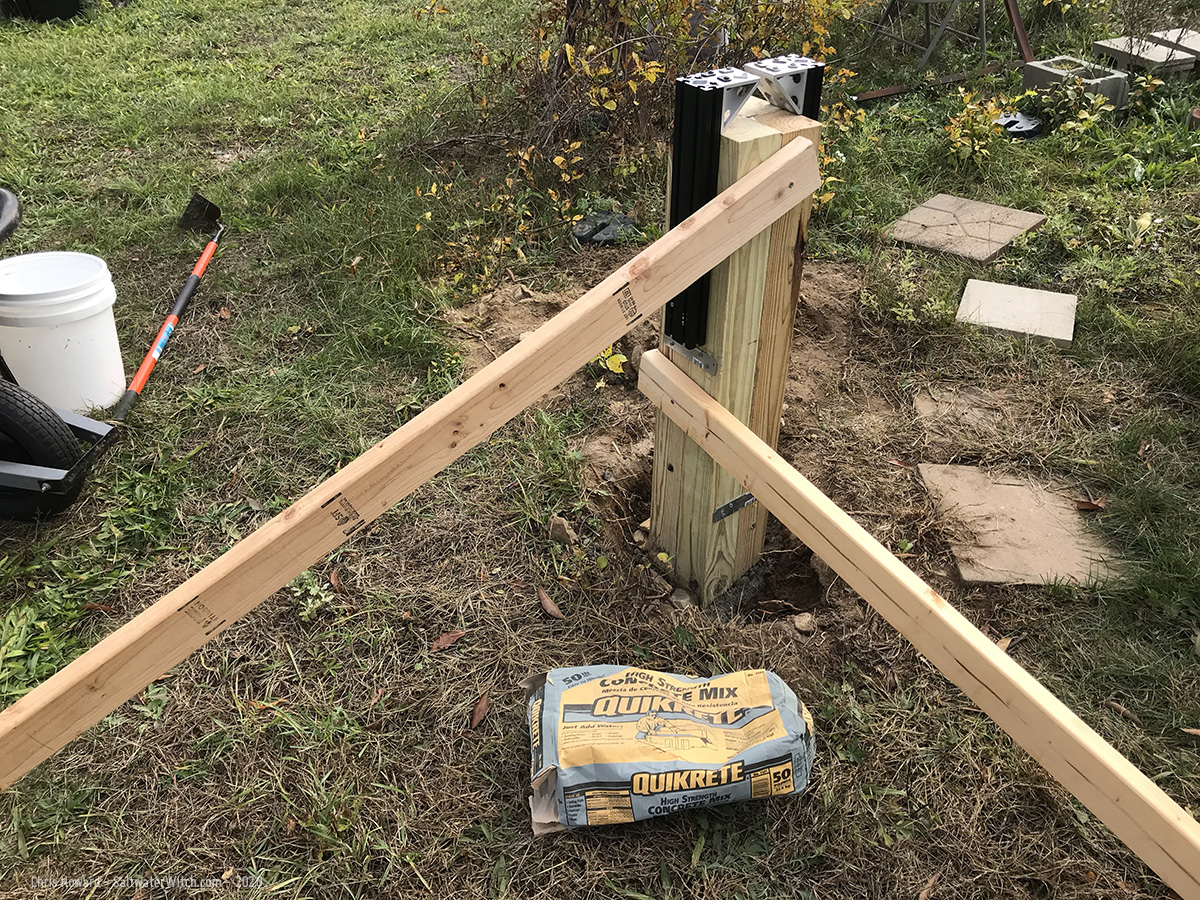 How is the Total RMS when guiding? Very good—what I expected. Depending on seeing and other factors I've been running with .5" to right around 1", which is as good as it gets for my skies and mount. The pier is rock solid. We'll see how four bolted together lengths of treated lumber behave over time, but I am not expecting any movement.
How is the Total RMS when guiding? Very good—what I expected. Depending on seeing and other factors I've been running with .5" to right around 1", which is as good as it gets for my skies and mount. The pier is rock solid. We'll see how four bolted together lengths of treated lumber behave over time, but I am not expecting any movement.
The distance from the reducer/flattener to the sensor is just a hair too far, maybe a millimeter off, so stars are slightly wonky. I'm still playing around with a few equipment details. Other than that, I'm really happy with these imaging runs. Start-up and shut down is so easy. This really is the next best thing to a backyard observatory. And building the walls and roll-off roof of a tiny observatory around the pier might be a next step, who knows? I also have my micro-observatory project still underway, but that only works with a small mount. I'm having an issue right now with the CEM25P, and I have to resolve that before I can get back to the micro project. At the end of the day, what's cooler than having a permanent astro setup in the backyard? Yup, two permanent astro setups in the backyard.
I went with Hydrogen-alpha for last night's run, and targets included with 60 x 240sec subs of IC 405 (Flaming Star Nebula) in Auriga, and 60 x 240sec subs of IC 2177 and NGC 2327 (Seagull Nebula) in Canis Major.
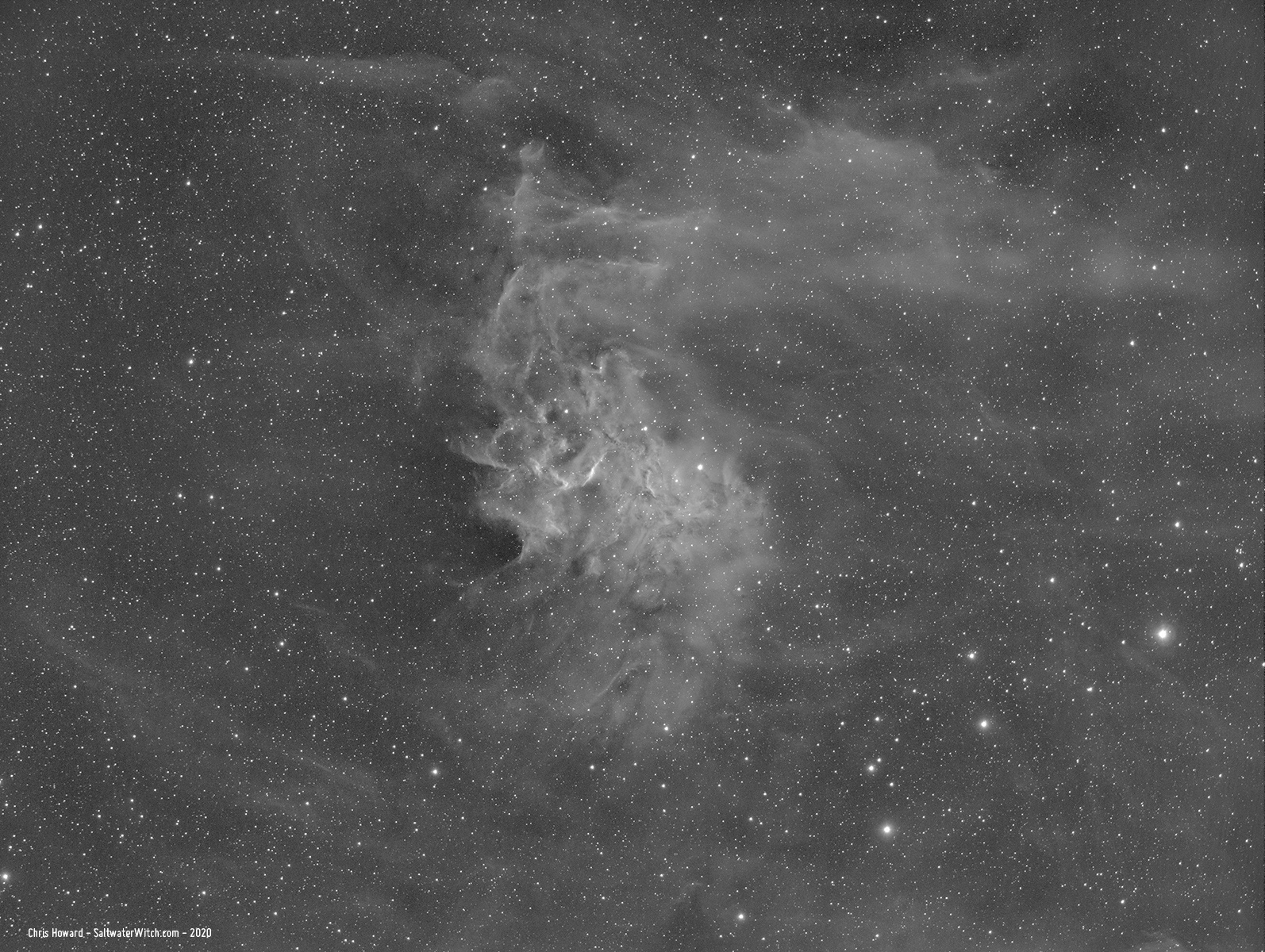
IC 2177, NGC 2327—Seagull Nebula:
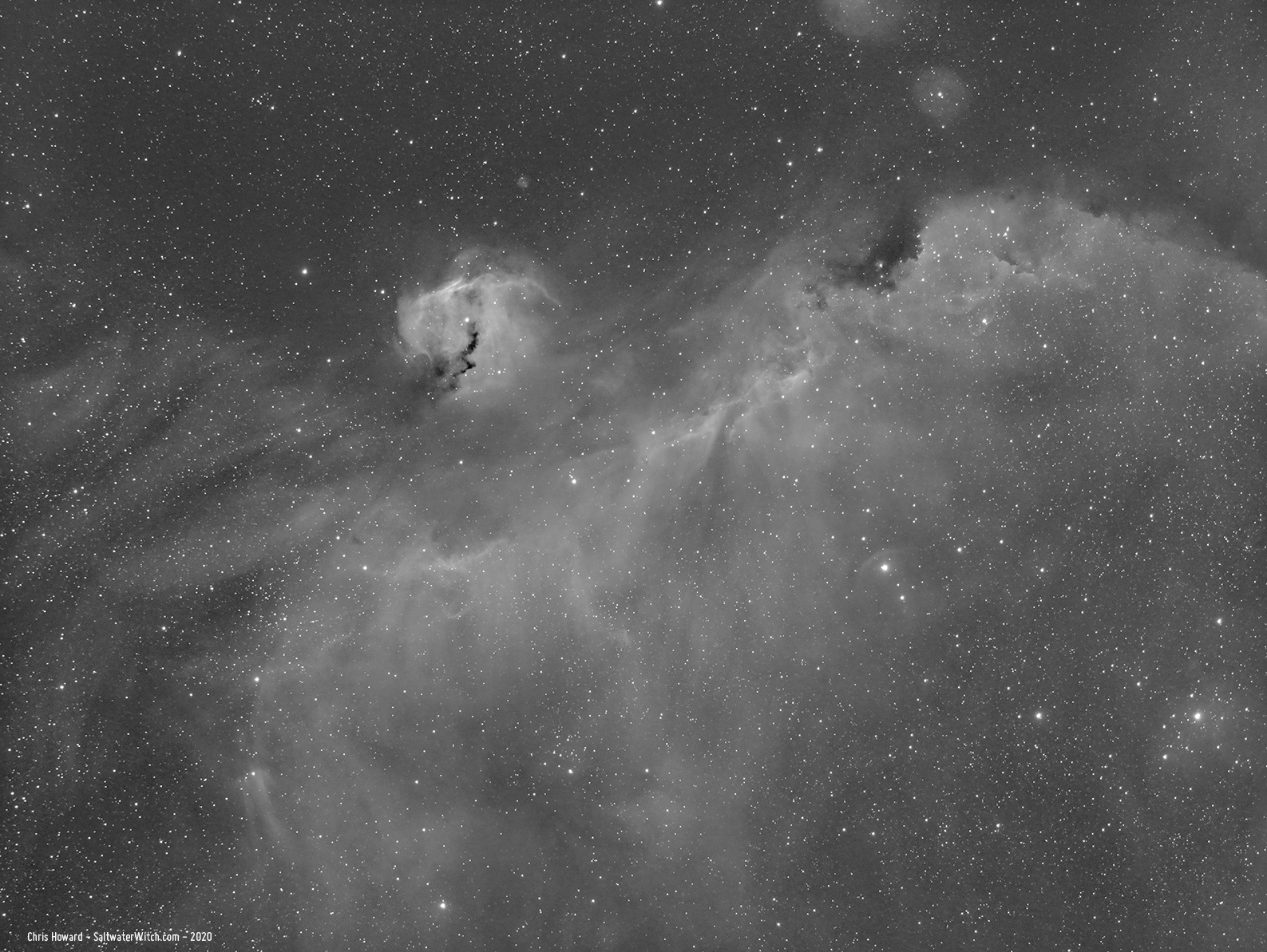
Gear notes: SkyWatcher EQ6-R Pro mount, William Optics GT81 Apochromatic Refractor 392mm at f/4.7, ZWO ASI1600MM-Pro monochrome camera, Astronomik 6nm filters, Moonlite focuser, Raspberry Pi 4 4GB / 128GB running INDI/KStars/Ekos
Posted November 19, 2020
Rosette Nebula and Surrounding Region
From the imaging run last night. The Rosette Nebula (NGC 2237) in the Constellation Monoceros is another deep sky object I typically capture every year--at least once! Trailing Orion across the sky, it's over a 100 light-years across and about 5000 lightyears away from us. 50 x 240 second sub-exposures in Ha. Gear notes: SkyWatcher EQ6-R Pro mount, William Optics GT81 Apochromatic Refractor 392mm at f/4.7, ZWO ASI1600MM-Pro monochrome camera, Astronomik 6nm filters, Moonlite focuser, Raspberry Pi 4 4GB / 128GB running INDI/KStars/Ekos

Rosette Nebula in the Constellation Monoceros (detail). You're looking at about 360 trillion miles of globules and globulettes—all those dark cloudy bits, running from the bottom middle of this frame to the top right. This is a detail view of my last Hydrogen-alpha image of NGC 2237 where interstellar gas and dust around one side of the Rosette Nebula have condensed into strings of dark cloudlets that block the emission from the core group of stars lighting up the broader background. Several of the stars that make up the cluster NGC 2244 are massive super-hot O-type stars, and these produce the stellar winds and intense radiation that have shaped the Rosette Nebula. To give you a sense of the scale here, pick any of the branches in those dark cloudy structures, or even most of the loose globules of condensing hydrogen. Our entire solar system can easily fit within the width of one of these. And I'm not talking about the orbit of Pluto; I'm using the Oort Cloud as the defining boundary, which would make the diameter of our solar system roughly 1.5 lightyears. In other words you can fit about 240 of our solar systems, lined up one after the other, in the same space as this chain of dark clouds. William Optics GT81 @f/4.7 Astronomik 6nm Ha filter, ZWO ASI1600MM-Pro mono camera.

Posted November 15, 2020
California Nebula in Ha + SII
Tuesday night I captured 50 x 4-minute sub-exposures in Hydrogen-alpha for NGC 1499 (California Nebula) and last night I captured 60 x 240 second exposures in Sulfur 2 (SII), combining them here into a color image, with Ha in red, SII in blue, and each shared equally across the green channel of an RGB image. There just isn't any OIII (Oxygen) in the mix for this massive emission nebula in the Constellation Perseus. Gear notes: SkyWatcher EQ6-R Pro mount, William Optics GT81 Apochromatic Refractor 392mm at f/4.7, ZWO ASI1600MM-Pro monochrome camera, Astronomik 6nm filters, Raspberry Pi 4 4GB / 128GB running INDI/KStars/Ekos

Posted November 15, 2020
The Orion Nebula in Hydrogen-alpha
I have to capture M42, M43, NGC 1977, the Orion, De Mairan's, and Running Man Nebulae at least once a year, and now through December is when the Constellation is high in the sky and still early enough be awake--I captured most of the 52 subs that went into this shot between 11:30 and 2am. This is just one filter's worth. I have to go back and either take OIII and SII or Blue and Green, using this Ha capture for the Red channel in RGB.
Imaging session notes: 52 x 240 second subs + 50 x 10 second subs for the Trapezium, stacked in DSS, processed in PS 2021. SkyWatcher EQ6-R Pro mount, William Optics GT81 Apochromatic Refractor 392mm at f/4.7, ZWO ASI1600MM-Pro monochrome camera, Astronomik 6nm Ha filter, Controller: Raspberry Pi 4 4GB / 128GB running INDI/KStars/Ekos.
